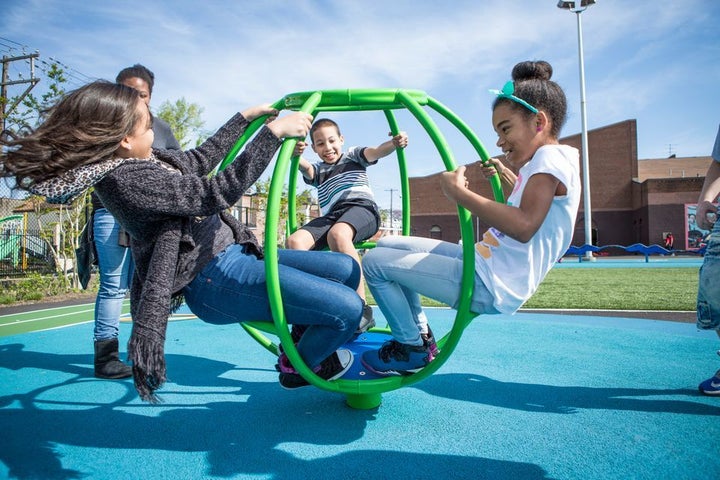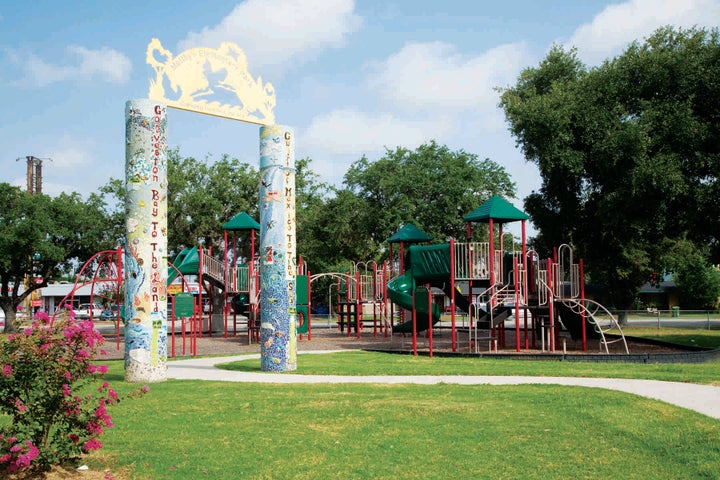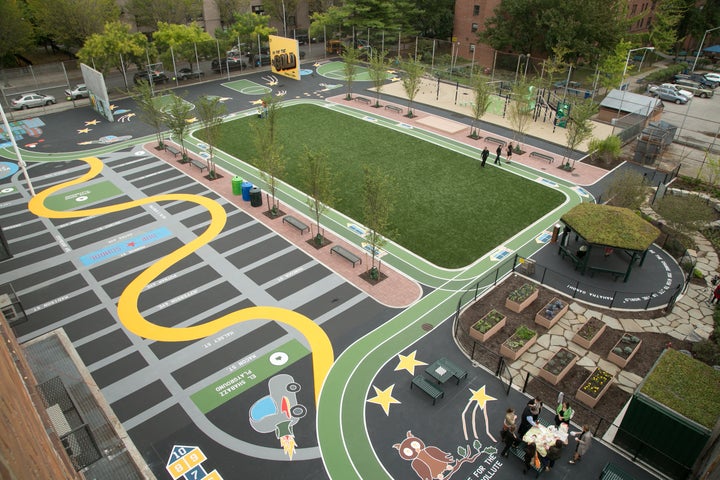Non-profits, 134 Mayors Launch National 10-Minute Walk to a Park Campaign

Children play in a schoolyard converted to a community playground in Philadelphia.
At a time when Americans are fractured by politics and policies, there is one thing most of us agree on and which has broad, bi-partisan support—convenient access to a high quality park.
Today, The Trust for Public Land (TPL), the National Recreation and Park Association (NRPA), and the Urban Land Institute (ULI) launched the 10-Minute Walk to a Park Campaign with the support of 134 mayors from cities across America and from both sides of the political aisle. These mayors signed on during the past year, endorsing the goal of providing every neighborhood with a quality park that improves life for city residents, serves as a safe place for people to gather, and adds to the beauty of the city.
Great parks are one of the anchors of healthy, sustainable communities and vibrant American cities. Today, more than 85 percent of the US population lives either in a city or a suburb, and the research is clear that close-to-home parks boost the wellbeing of entire neighborhoods. Parks play vital roles in enhancing environmental sustainability, absorbing carbon and other air pollutants, lowering temperatures, and capturing storm water runoff. They are also crucial to public health—data show that when people live near parks they exercise more. Parks also enhance property values, and create community cohesion by bringing diverse people together in social settings. Cities that invest in parks and open spaces are directly benefiting local residents and their physical and mental health by creating life-enhancing ways to get outdoors and be active.
In cities across America, mayors and park directors are working with other elected officials, citizens, and non-profit partners to come up with visionary ways to pay for new parks, and improve existing parks.
For example, the city of Houston has made a bold and ambitious goal to increase the number of residents who live within a 10-minute walk of a park from 48 percent to 75 percent by 2040. To do this, they have made improved access part of its official park master plan. Working with a non-profit partner known as Spark Parks, city officials are identifying scores of schoolyards that could be converted into community parks. Likewise, in hundreds of cities across the country, underused schoolyards represent the “low-hanging fruit”—land already owned by the city, possibly not even needing major improvement—just the stroke of a policy pen to make them “joint-use’ facilities and creating more nearby outdoor spaces for tens of millions of Americans.

Matthys Elementary School Park in Houston, newly renovated and opened to the community through the SPARK Parks program.
In Los Angeles County last year, residents approved Measure A, which will generate at least $1.8 billion—$100 million a year, indefinitely—for new and improved parks across the county. In Boston, voters also last year approved a Community Preservation Act measure that will generate $20 million for the same cause, and New York City has allocated $300 million to renovate 70 small parks and playgrounds in underserved areas. In Minneapolis and San Francisco (which recently became the first city in America where 100 percent of its residents have a park within 10-minute walk), park leaders worked with community residents and local leaders to solve equity problems, and to make sure everyone, regardless of income or race, has access to high quality parks. Both cities have set aside large amounts of funding to ensure equitable park quality.

San Francisco Mayor Ed Lee announces that his city is the first to have 100% of its residents within a 10-minute walk of a park at an event in Hilltop Park.
So, where did the “10-minute walk” idea come from? For several decades, city planners and social scientists have measured distances people will travel on foot to basic services such as shopping, schools, or transit. They concluded that half a mile is about as far as people will reasonably walk. Though walking speeds vary, the U.S Department of Transportation agrees that most people can walk a half-mile in 10 minutes.
Nearly 17 years ago, at an all-staff gathering of The Trust for Public Land, Will Rogers, who still serves as the organization’s President, talked about headlines he hoped to see in the next decade. One of those headlines was his prediction that the NRPA and US Conference of Mayors would join TPL in working to ensure that no one lived “more than a 10-minute stroller ride from a park or playground.” A few years later, in an article penned for the American Planning Association Journal in 2004, Peter Harnik documented cities that had standards for how far residents should have to walk to get to a nearby park. Harnik, then Director of The Trust for Public Land’s Center for City Park Excellence, found that most cities had no standards, and those that did ranged from a tenth of a mile to a mile, with about half having a half-mile as the standard.
A year later, Jack T. Linn, Assistant Commissioner in the New York City Department of Parks & Recreation, developed a new standard for the ideal walking distance to a park. He determined that it should be measured in time, not distance, and proposed that every New Yorker should have a park or playground within a 10-minute walk.
That standard was adopted two years later in PlaNYC—the sustainable development plan for New York City under Mayor Michael Bloomberg.
As a centerpiece of PlaNYC’s park and environment program, the Mayor called for converting 250 part-time, asphalt schoolyards into fulltime community playgrounds, used by schools during school hours but available to neighborhood residents after school and on weekends. That move, accompanied by $150 million to improve the playgrounds, led to a 15 percent increase in the number of New Yorkers who had a park or playground within a 10-minute walk.

The old asphalt schoolyard at La Cima Charter School in Brooklyn, NY was converted by The Trust for Public Land to a green community playground that also captures stormwater runoff.
Last June, the US Conference of Mayors (USCM) validated Will Rogers’ prediction by officially endorsing the 10-Minute walk in a resolution introduced at its national gathering. The USCM resolution said, in part “that the United States Conference of Mayors supports the goal for cities to increase the number of people in urban America who live within a 10-minute walk of a high-quality park; that the [USCM] will celebrate mayors that make quality parks and access to them a first-tier solution to their municipal challenges; and that the [USCM] supports investments in parks and open spaces with the goal for everyone in urban American to live within a 10-minute walk of a high-quality park.”
There was another major challenge for the 10-Minute Walk partners when they launched the campaign nearly three years ago: How could they know how many people had 10-minute walk access to a park in the 14,000 communities within the 3,000 areas defined as “urban” by the U.S. Census Bureau? The answer came in TPL’s award-wining Geographic Information Systems (GIS) unit, which created ParkServe, an effort to find and map all the parks in those 14,000 communities, and then to figure out how many lived within or outside of the 10-minute walk “service areas” of those parks. Working with the help of Esri, the world’s leading GIS mapping company, and using their Network Analyst software, they are tracing the street network to determine if and how someone could walk to a park—without encountering barriers such as freeways, rivers and canals, or railroad tracks.
ParkServe, now underway for two and a half years, has already surveyed 7,600 of the 14,000 communities, encompassing 67 percent of the U.S. population. Based on preliminary analysis, they estimate that as many as 150 million Americans may not have a park within a 10-minute walk. ParkServe is also generating the nation’s first-ever database of urban parks and providing tools that city officials and citizens alike can use to help identify park deserts and the best ways to add green oases.
So now that the campaign is officially launched, and is supported by 134 mayors, how do we close that gap for so many Americans?
First, the three partners, TPL, NRPA, and ULI, working with other non-profit organizations, will engage with mayors and cities to deploy tools and strategies to help them increase access to new parks and improve existing parks, building on successful models and strategies already in place. TPL and ULI experts in conservation and urban park finance are working with cities to identify both traditional and new sources of funding for park creation and improvement, from voter measures and bonds to tax-increment financing and social impact bonds. ULI will use its 51 regional councils to work with local leaders and deploy advisory panels representing developers, planners, financiers, economists, and public officials to provide practical and objective advice to cities.
The campaign soon will launch a competitive grant program, challenging cities to come up with innovative approaches to adding and improving parks. This program will build on traditional NRPA strengths in research on best practices, case studies, and comprehensive data, including its Safe Routes to Parks program, to help make the case for expanded park funding.
So, with all this effort and energy, Americans in cities and suburbs across the country may soon have close-to-home access to the aspect of city life that may best define quality of life: a high-quality, green, and safe park for all to enjoy.
